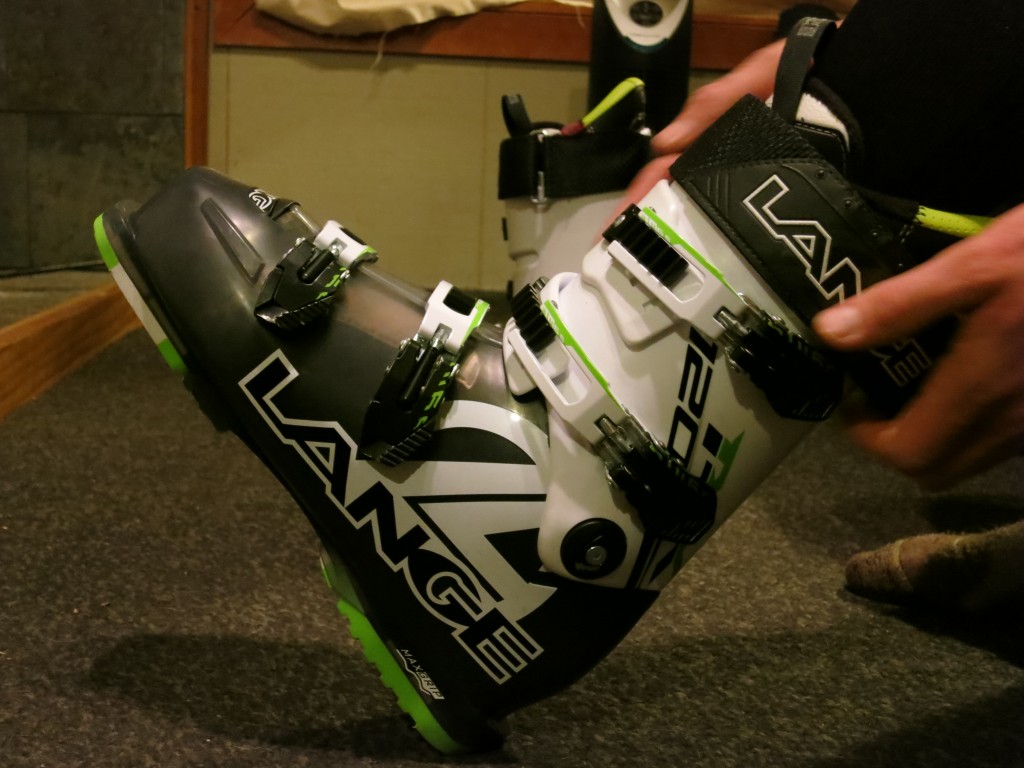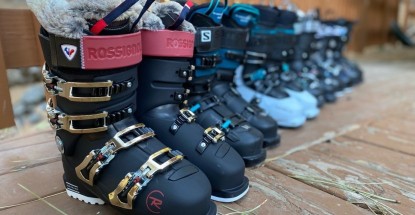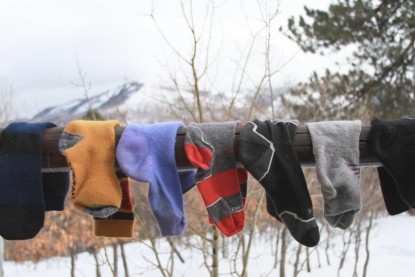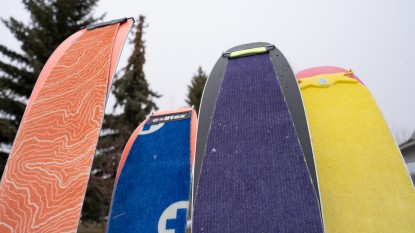Buying a pair of ski boots can be an overwhelming process. There are many reputable brands on the market, each selling several different models that suit different needs. Some boots have more features than others, and sorting out the most useful for you can make choices difficult. To make matters worse, each model may have variations in flex and width. How do you choose which boot will suit your needs the best?
We did a full comparative review of ski boots, so to see which models our professional test team liked the best, reference our Best Ski Boot Review.
Ski boots are a highly personal piece of equipment. Their performance, comfort, and warmth depend mostly on fit, your skiing style and needs, and your taste. To ensure the best fit, we recommend seeking the advice and services of a professional boot fitter. A boot fitter can measure your foot, ask you questions, and make initial recommendations based on their experience and knowledge of particular products.
If you are purchasing ski boots from an online retailer, consider the ease of returning the product to the seller if you need to exchange them for another size or model. If possible, try on a couple of different sizes from different brands so that you can compare them and decide which shape and size are most suitable for your foot and skiing ability.
This article will introduce some basics in choosing a ski boot that fits your foot and some of the features to look for on modern all-mountain ski boots.
Types of All-Mountain Alpine Boots
Traditional Style Alpine Boots
These boots consist of a traditional two-piece shell and cuff design. Both the lower shell of the boot and the cuff overlap to provide increased stiffness in the front of the boot and keep out snow and water. Examples of traditional models from this test include the Tecnica Mach1 130 and the Lange RX 120.
Adventure-Freeride Boots
Related: Best Backcountry Ski Boots of 2025
The Anatomy of a Ski Boot
Ski boots are relatively simple contraptions. They are meant to provide a positive connection between your body and your skis. Materials and features of boots may vary across manufacturers and models, but there are universal components that make up a modern alpine ski boot.
Shell
The shell of the ski boot is the hard plastic outer boot.
- Shell materials contribute to the weight and stiffness of a ski boot. Polyurethane is common in race and alpine boots, while Grilamid, a lighter material, is common in touring boots.
- Professional boot fitters can adjust shells for specific places where the boot may be too tight on your foot, despite an otherwise good fit.
- Certain boots, such as the Tecnica Mach1 or the Nordica Speedmachine 130, have shells that are heat-moldable to shape to the general contours of your feet and provide a more precise fit.
Liner
The boot's liner is a removable soft inner boot contained within the shell of the ski boot. It is an important consideration in purchasing a ski boot.
- Heat moldable liners add value to your investment because they are an easy way to achieve a more customized fit. CAS from Tecnica or IT from Dalbello are examples of this nearly ubiquitous feature.
- Heat moldable liners are cooked in a boot fitter's oven, reinserted into the shell of the boot, and when you put your foot inside and buckle the boots, the now malleable liner will shape to the contours of your foot, giving you a custom fit.
- With time, heat-moldable liners will shape to the skier's foot just by skiing in them.
Sole
- Excessive wear on the sole can affect the boot's connection with the binding and, therefore, the skier's safety.
- Boots that do not have removable soles can be preserved by avoiding walking on pavement, dirt, and other hard surfaces. Aftermarket products such as YakTrax can be used while walking to protect the boot sole.
Footbed
The footbed inside the liner gives your foot support.
- Footbeds that come in boots from the manufacturer tend to be thin pieces of foam that offer little support.
- We recommend purchasing an aftermarket footbed such as Superfeet to improve the fit of your boot and preserve the health of your feet.
Buckles
- Having micro-adjustable buckles allows for a more precise fit. Micro-adjustable buckles will twist to lengthen or shorten their shaft, which serves as an intermediate adjustment between the regular ladder steps on the buckles.
- Buckles should be easy to operate with gloves on.
Power Strap
- Power straps can utilize velcro for closure or some sort of camming buckle.
- Wide power straps are more effective than skinny straps. They have more velcro to hold them in place and will slip less.
Walk Mode
- A walk-mode enables the skier to disengage the boot's cuff from the bottom of the boot, enabling some freedom of movement in the ankle. This makes walking in the boots or traveling uphill using climbing skins much easier.
- This is a nice feature for skiers who walk or hike in their boots often or if you are starting to venture outside the resort boundary using alpine-touring equipment.
Recco Reflectors
- The reflector is a passive chip that can be picked up by a receiving unit that functions similarly to an avalanche beacon.
- This could be an added piece of insurance for skiers that frequent avalanche terrain within and near resort boundaries.
Trying On and Sizing Boots for Skiing
Before trying boots on, you should have an idea of the general shape of your foot, the length and width of your foot, your skiing ability, and the application of the boot. With this information, you can look for a boot in the correct size, last width, and with an appropriate flex rating for your ability or preference.
Sizing
Mondo Point System
Ski boot manufacturers use the Mondo Point sizing system. It is a measurement of the length of your foot in centimeters. There are conversion charts that can show you what your street shoe size equates to in Mondo Point, or you can have your feet measured. This is a good place to start.
- As an example, a Mondo Point 27.5 roughly equates to a US size 9.5 M and 11 W.
- Shell sizes tend to be measured on the whole size (27.0, 28.0, etc.). Half sizes are created by adding more padding to the liner or putting a thicker footbed in the liner.
To measure your feet at home:
- Put a piece of paper, larger than your foot, on the floor against a wall.
- Stand on the paper with your back and heels glued to the wall.
- Draw a line marking the longest part of your foot.
- Measure the distance in cm from the edge of the paper to the line you've just made.
Last Width
The last of a boot refers to its general shape and width inside the shell (outer boot). Generally speaking, narrow width boots will be somewhere in the 97 to 98-millimeter range, medium width boots will be in the 100 to 102-millimeter range, and wide boots will be 102 millimeters and larger.
- Narrow lasted boots tend to be lower in volume. They are suited for skiers with small feet or those seeking a very snug, performance fit.
- Medium lasted boots will be comfortable out of the box for most people and those with an “average” sized foot.
- Wide lasted boots are made for people with wide feet that need extra space or want more comfort.
Some brands design a boot with three shell sizes or volumes under the same name. Tecnica offers the Mach 1 in a high volume (103-millimeter last), medium volume (100-millimeter last), and low volume (98-millimeter last). Other brands offer similar boot performance in different last widths under different names. For example, Nordica alpine boots are comparable in performance, but the high volume and wide last boot is called the Sportmachine (103 millimeters), the medium volume and last is called the Speedmachine (100 millimeters), and the low volume and last boot is called the Promachine (98 millimeters).
These boots are comparable in performance, but generally, manufacturers offer higher flex ratings and better performance in their low and medium volume boots, while larger boots are usually for intermediate skiers. The idea behind this is that to achieve optimal performance out of a boot, it should be snug, even if you have large feet. This can make shopping for the right boot a little confusing.
Boot Sole Length
The length of the boot sole is measured in millimeters. The actual length of the boot from the toe to the heel will vary, even if they are the same size.
- Check the sole length of your current boots before stepping into your bindings with new boots. They may not fit.
- You should have your bindings checked every season with the boots that you will use with those skis/bindings.
Boot Stiffness
The flex rating of a boot refers to how difficult it is to flex the boot forward. It basically tells you how stiff the boot will feel. Skier ability, size/weight, skiing style, and personal preference may determine what “flex” boot is appropriate.
- The flex rating is expressed using a number. You will find men's models rated from about 50 to 130. The higher the number, the harder the boot is to flex forward, and in turn, the stiffer it feels.
- In general, beginner skiers will get more out of a softer flexing boot, while advanced and more aggressive skiers will appreciate a boot that is harder to flex.
- The flex rating can usually be found marked somewhere on the cuff of the boot, probably in conjunction with the model name. Many models will be available in different flex ratings, and some can be adjusted easily to be slightly stiffer or softer.
- Some models, such as the Nordica Speedmachine, offer an adjustable flex that can be turned up or down in a range of usually ten units.
- Unfortunately, the flex rating metric is not standardized between manufacturers, and it can be difficult to compare the stiffness of boots from different brands without trying them on.
Sizing Tips
We suggest trying on ski boots later in the day. Feet tend to swell a bit throughout the day and at higher elevations. By trying boots on in the afternoon or evening, you are helping to mitigate the risk of buying boots too small. Try boots on (and ski) while wearing very thin wool or synthetic socks. They help wick moisture away from your skin, are resistant to bunching up, and provide a more precise fit. Thick socks can restrict circulation and will actually make your feet feel colder.
- The most important tip is to size the shell to your foot first.
- Remove the liner from the shell and carefully insert your socked foot into the shell. Stand up and slide your toes to the front of the boot so that they are just touching the end.
- You should have no more than two fingers width between your heel and the back of the boot.
Then, try on the boot fully assembled.
- Reinsert the liner carefully into the shell.
- While seated, insert your socked foot into the boot. Buckle the top buckles loosely.
- Kick your heel into the ground to seat your heel and ankle into the heel pocket of the boot. Tighten the power strap of the boot, which in combination with the top two buckles, will more firmly seat your heel and ankle in the heel pocket of the boot.
- Now tighten the buckles at the forefoot of the boot.
Stand up to see how the boots feel. Keep in mind:
- Ski boots are meant to be snug.
- As you stand up straight in the boot, your toes should barely touch the end of the liner. Flex into the tongue of the boot as if you were skiing and feel your toes pull back slightly from the end of the liner.
- You should not be able to lift your heel easily, and there should be little to no lateral play in your forefoot.
- Wiggling your toes is a good thing, but too much dead airspace may indicate that the boot is too large for you.
- Adjust and micro-adjust the buckles as needed.
- Tighten the power strap to maintain positive contact with your shin.
A precise fit of your boots will increase performance, make them more comfortable, and reduce the risk of a foot injury. Again, it is strongly recommended to visit a professional boot fitter to help you choose a boot that is right for you and make adjustments to the boot as needed.
The Bottom Line
Buy boots that fit your feet well. Seek professional boot fitting advice if you are having trouble finding a good fit, and try on several different boots in different sizes before buying. Ski boots should be snug without being painful, and you should be able to wiggle your toes but not be able to lift your heel. There should be little to no lateral movement in your forefoot.
Choose boots that suit your needs. They need not be overly stiff if you are a beginner or intermediate skier or not an aggressive skier. If you are crossing over to skiing outside the resort boundaries or want to access hike-to terrain in-bounds on occasion, consider a boot with a walk-mode feature. Consider your budget and how much you ski; there is no need to get an expensive boot if you only ski a handful of days a year. There are affordable boots with excellent features that could fit your feet well and provide good ski performance at your level.























